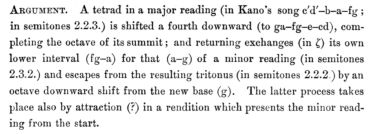Traditional Hopi Songs - online book
Native American Songs With Sheet Music, Notation & Commentary
| Share page | Visit Us On FB |
|
MALO-KATCINA 113
 The outdoor music of the collection begins with this gay, almost rollicking melody, shaded by both singers from a stentorian opening to a whispered close. The preceding songs have warranted the anticipation of both exact repetition and free variation in renditions of the same air by different performers; but if the divergence between Kano and Masi-umtiwa is therefore not surprising, the precision with which they weave the pattern both follow nevertheless is. In the diagram of Kano's song the notes in circles embody the identical order of intervals that their homologues similarly indicated compose in Masi-umtiwa's song, performed a major third higher. Taking off a tracing from one diagram and applying it to the other so that the goals of the first downward movement (ending at fg— in Kano's song) coincide as a common start, the diagrams " register," to use the printer's word, at the notes in circles. The rise from the start was made through a tone, the fall thereafter through a § tone by both singers: both pitched the reiterated note before the high leap later a third tone, and the passing note from which it was taken a sixth tone above the start; both pitched the climax of the song a sixth tone over a major sixth above the start; both began their second downward leap in B1 at a semitone, and in B2 at a § tone above the start; and when at the end of B2 they parted company, each to execute his own coda, both had reached a pitch a sixth tone less than a major seventh below. Meanwhile the axis of the song had been sprung through an approximate semitone by each in his own way. Such exactness would be hardly credible were it not substantiated by two mechanical records.
The song adds another to the endlessly varying dramas of melodic |
||
|
i |
||